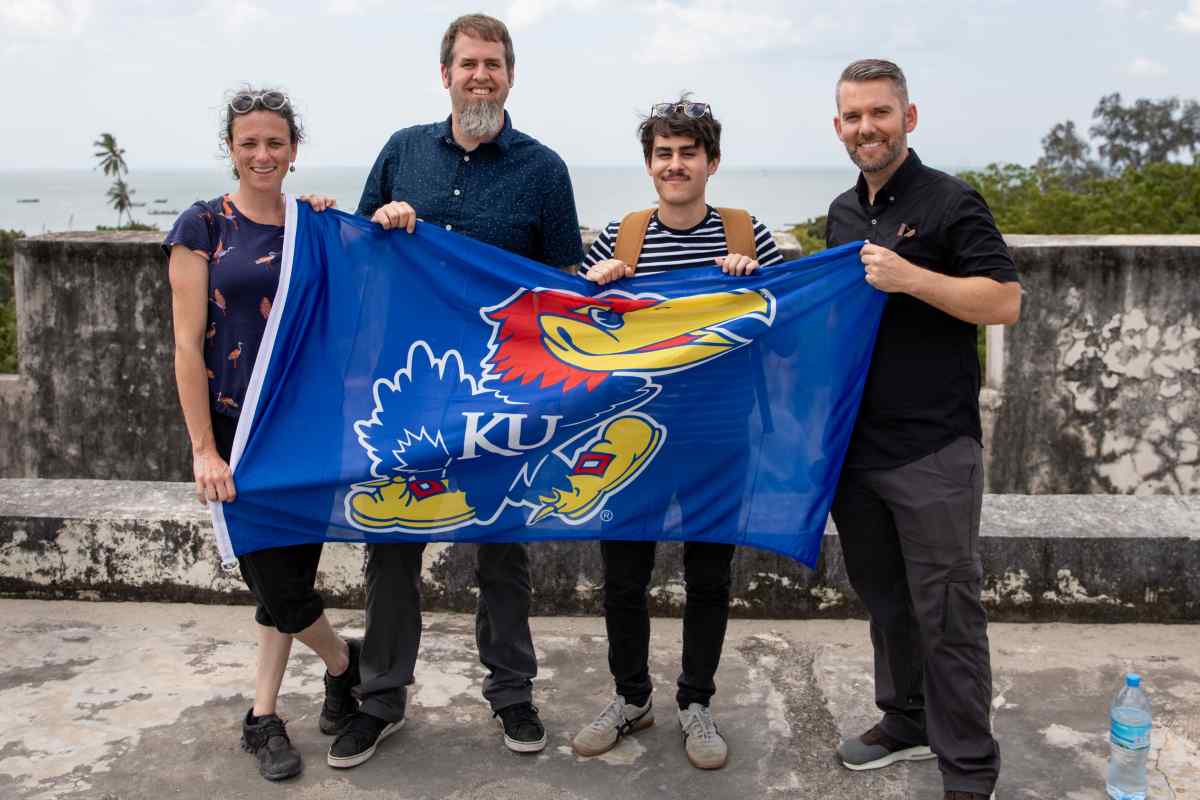Finding the brand abroad

On a cloudy day in the Bagamoyo district of Dar es Salaam, Tanzania, with the Indian Ocean lapping lazily in the distance, five Jayhawks smiled for the camera. Those Jayhawks — four humans, including myself, and Hal Sandy’s blessed bird in convenient flag form — had traveled 9,000 miles to be there. Look past the lingering jet lag and you’ll see proud Kansans ready for an adventure.
We weren’t the only Jayhawks there that day. Just outside of frame were 10 students and faculty, members of ColLAB: Bridging East Africa’s Digital Health Divides, a KU research initiative that focuses on health access in East African communities. ColLab was about to begin its second field school, a two-week trip to Tanzania where undergraduate and graduate students put their African Studies and Kiswahili language skills to the test, conducting field research in the native language and immersing themselves in the local culture.
As photographers, videographers, and storytellers for Marketing Communications, our job was to document the field school activities in and around Dar es Salaam. We saw the field school as an incredible opportunity to capture KU excellence in an environment wholly different from the midwestern calm of Lawrence, Kansas, with some of KU’s highest achieving students.
The KU students included Foreign Language & Area Studies and Fulbright fellows, TRIO McNair scholars, and Undergraduate Research Award recipients. They came from a variety of disciplines — chemical engineering, medical anthropology, political science, and women, gender & sexuality studies (as ColLAB co-director Katie Rhine puts it, “interdisciplinary to the max”).
On our first day in the city, with the bitter aftertaste of bad airline coffee barely brushed from our mouths, we got a taste of just how immersive the next week would be. We spent the afternoon at an expansive textiles market, several city blocks of street vendors pitching their wares, calling out in Kiswahili, wooing you with gestures indicating that this shirt would look great on you. The lunch hours I‘d spent before the trip toiling away on Duolingo went out the window as I wended through the crowds of merchants. “Niko sawa,” a ColLAB student taught me to tell them — “I’m good.” It was exhausting, and I loved every moment.
These mild jolts of culture shock would continue throughout the week. After all, neither I nor my colleagues had ever been to East Africa. Even though we’d done our homework, certain uncertainties come with being nine time zones from the nearest Dillon’s. And it wasn’t just us. Only two of the students at this year’s field school had gone on the first trip in 2018. In speaking with the newcomers, a running theme was the major differences between learning in a classroom and being immersed in the culture. Your research — and the interactions by which you conduct it — live and die by your language skills and how well you can build impromptu researcher-subject relationships in the field.
If they had any misgivings, however, the students worked with grace and curiosity. And most importantly, they worked together. The word “collaboration” cropped up so often in our pre-trip interviews with ColLAB students and faculty that it started to lose its meaning. It wasn’t until I saw the field school in action that I really understood that ColLAB is more than just a convenient play on words — it’s a promise of honest-to-god collaboration, a union of disparate fields and skill sets with a common goal.
“Duh-doy, Justin,” you sigh into your screen, “that’s called academia.”
I understand how pollyanna and un-revelatory it may sound, but spending a week with these students in close quarters, aboard endless bus rides, in the field, you learn how important strong relationships are, not just with your subjects, but also your colleagues. And the ColLAB students kindly welcomed us into the fold, too. They were forgiving of our clumsy scraps of Kiswahili and taught us more useful phrases when necessary. They were accommodating of our incessant questions and more unusual requests (we were, after all, a camera crew). They assisted us through difficult interactions with locals, and let us hang when it would make for a better story over dinner.
Near the end of our stay, we were asked to deliver a brief presentation about our work and the KU brand. As I stood in front of the room, laser-pointing the components of the brand pyramid, I had a striking realization: This is redundant. We’d just spent several days in the trenches with these students, embodying the KU values that Marketing Communications works so hard to capture. They didn’t need a tidy pyramid to know what makes them Jayhawks. To quote Pee-Wee Herman: “I don’t have to see it, Dotty. I lived it.”
It’s a dusty but fundamental truth, that rediscovery of hometown values that can only hit you in faraway places. As we boarded the first of several lengthy flights back to the states, I felt reinvigorated, the crimson and blue fire in my belly burning bigger and brighter than ever. I wasn’t burdened by the calculus of university deadlines or student recruitment or any of the other ephemeral concerns that concern campus communicators. All I cared about were the Jayhawks, atop Mount Oread and beyond, transforming the world. As I write this, they’re flocking and fluttering outside my window. They’re giving us all a reason to smile.